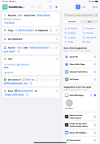Bjorn
GTD Trainer L1
Here are some thoughts after a year of using a digital notebook device to capture handwritten notes.
I use a ReMarkable 2, which is an impressive device, but surely you can apply these thoughts no matter what device you’re using.
When I write meeting notes, I jot down keywords of the discussion topics chronologically. Keywords, since I want to write and still participate in the meeting with focus. This is a great help during the ongoing meeting. I can follow and reflect on the topics as the meeting proceeds.
Summarizing the main output of the meeting is also important. At the end; I write all key takeaways. Next time I see the note page, I look for the summary at the end and can find out what the outcome was.
I mark all captured next actions with a check box at the beginning of the line. It makes it easy to find them after the meeting. If a task is delegated, I mark this with a ‘W’, indicating I’m waiting for this task to be completed.
I mark the check boxes as completed latest during my Weekly Review, when I review all my notes and move them to my task manager, either to the next actions-list or waiting for-list. When I have reviewed a notebook, I create a new page with a large checkbox and the date of the review, nothing else. This is a bookmark in the form of a nearly empty page. The next time when I review the notebook, I can easily see where I should start, since everything written before the review page is already handled.
The structure of the notes in multiple notebooks is probably a highly personal decision. I work with different clients, so each client has a specific notebook. Another perspective is to use the areas of focus or responsibilities as structure.
If a find that a note is of special interest, I move it from my device into my reference archive either using a picture or a PDF.
One of the differences between using a digital notebook and a paper-based one is the near-endless amount of storage available, all notes can be saved; creating a diary for the future.
How do you use digital handwritten notes? Please share, it would be interesting to learn from others.
I use a ReMarkable 2, which is an impressive device, but surely you can apply these thoughts no matter what device you’re using.
When I write meeting notes, I jot down keywords of the discussion topics chronologically. Keywords, since I want to write and still participate in the meeting with focus. This is a great help during the ongoing meeting. I can follow and reflect on the topics as the meeting proceeds.
Summarizing the main output of the meeting is also important. At the end; I write all key takeaways. Next time I see the note page, I look for the summary at the end and can find out what the outcome was.
I mark all captured next actions with a check box at the beginning of the line. It makes it easy to find them after the meeting. If a task is delegated, I mark this with a ‘W’, indicating I’m waiting for this task to be completed.
I mark the check boxes as completed latest during my Weekly Review, when I review all my notes and move them to my task manager, either to the next actions-list or waiting for-list. When I have reviewed a notebook, I create a new page with a large checkbox and the date of the review, nothing else. This is a bookmark in the form of a nearly empty page. The next time when I review the notebook, I can easily see where I should start, since everything written before the review page is already handled.
The structure of the notes in multiple notebooks is probably a highly personal decision. I work with different clients, so each client has a specific notebook. Another perspective is to use the areas of focus or responsibilities as structure.
If a find that a note is of special interest, I move it from my device into my reference archive either using a picture or a PDF.
One of the differences between using a digital notebook and a paper-based one is the near-endless amount of storage available, all notes can be saved; creating a diary for the future.
How do you use digital handwritten notes? Please share, it would be interesting to learn from others.

